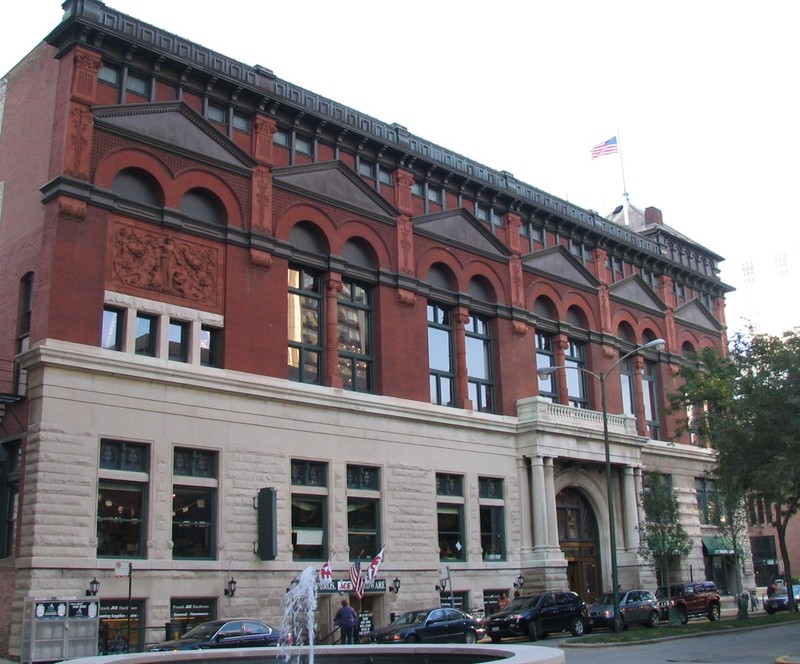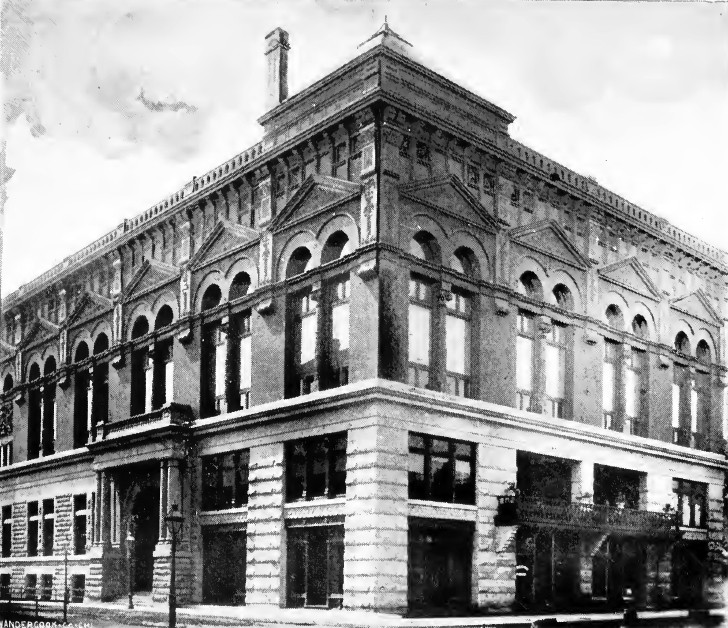Germania Club
Introduction
Text-to-speech Audio
The ornate Germania Club Building was constructed in 1889 within Chicago's Near North Side neighborhood and offers a reminder of the city's many ethnic neighborhood social and fraternal clubs. Germans comprised one-quarter of Chicago's population (1.7-million) at the turn of the century. This club was at the center of Chicago's large German enclave. After openly supporting Germany in the early years of World War I, club members decided to rename their organization the Lincoln Club. The organization operated as a social club at this location until the 1980s. In addition to the architectural significance of the building, the structure is historically significant as a reminder of the influence of the organization and its members at the turn of the century.
Images
Southern facade of the Germania Club,(1888) Chicago, Il, Addison & Fiedler, architects

Germania Mænnerchor Building, 1891

Backstory and Context
Text-to-speech Audio
Built in 1889 by leading members of Chicago’s German-American community, the Germania Club served as the epicenter of Chicago’s German-American community. This community was one of the largest and most influential in Chicago at the turn of the twentieth century. The name changed to the Lincoln Club during the first World War when anti-German sentiment grew, notably because Germans in the club initially supported Germany and provided funds to support the German war effort prior to American entry in 1917.
Multitudes of Germans immigrated to the United States, including to Chicago, during the late nineteenth century and early twentieth century, largely due to political and economic issues in Germany that inspired Germans to emigrate. Germans were among the first Europeans to arrive in Chicago and by the 1850s grew to become Chicago's second largest ethnic group after the Irish. During the last three decades of the nineteenth century, 300,000 Germans immigrated to Chicago so that by 1900 Germans comprised a quarter of Chicago's 1.7 million residents.
At the turn of the century, a significant and influential Germans enclave existed on Chicago's north side, ranging from wealthy entrepreneurs to those among the working-class. The Germania Club existed in the heart of that profoundly German portion of Chicago, along with a host of German shops, stores, and bakeries (to name a few), earning the nickname “German Broadway.” In fact, it would have been difficult to function in that neighboorhood without knowing German -- the dominant language that was spoken there.
The genesis of the Germania Club occurred at the end of the U.S. Civil War when Germans who had fought in the war sang at ceremonies held at the Chicago Court House as President Lincoln’s funeral bier passed through Chicago on route to Springfield. That musical group eventually organized formally as the Germania Männerchöre (German men’s chorus), largely catering to the upper class and social elites throughout the 1870s.
The evolution of the Männerchöre in the 1880s included expanding its reach beyond music, thus a building became necessary. By September of 1888, the cornerstone was laid during a ceremony where Mayor John A. Roche’s noted its significance as a sign of assimilation, lauding Germans in Chicago for honoring Germany and their new Chicago, American homeland. The Germania Club Building was completed on April 7, 1889, and In 1902 the Germania Männerchöre name was dropped in favor of the Germania Club.
Not only did the building cater to Germans -- though it did allow for non-German membership (mostly elite Anglo-Americans), it abounded in German craftsmanship. The terra cotta used on the exterior was supplied by the Northwestern Terra Cotta Company, owned by German and Austrian immigrants in Chicago, which grew to become of largest in the country by the 1930s.
Though many ethnic enclaves included a community center, the Germania Club enjoyed remarkable longevity, operating as a German center for 97 years until the dissolution of the club occurred in 1986. During this period, the club hosted many dignitaries and celebrities such as Albert Einstein, composer Richard Strauss, and Prince Heinrich of Prussia, the brother of German Kaiser Wilhelm II.
Though the Germania Club attempted to remain apolitical, members included Illinois Govoner John Peter Altgeld, who pardoned three of the jailed Haymarket Affair defendants. In 1895 the club celebrated Otto von Bismarck’s 80th birthday and in 1899, the club commemorated the 50th anniversary of the German uprisings of 1848.
The pro-German stance and association with local politics created issues for the club during World War I. At the start of the war, Chicago's German-Americans openly supported Germany and even side; raised funds for the German Red Cross. As American sentiment grew to support Germany's enemies, the club and local Germans were forced to suppress their German identity so that in 1918 the club board voted to rename itself the Lincoln Club.
By 1934, membership in the Germania Club had dropped to only 63 people and the club declared bankruptcy in 1935, but it found a way to survive the Great Depression just as the Nazi regime was gaining momentum in Germany. In 1938, 1,000 people gathered at the Germania Club to hear a speech presented by Gerhard Wilhelm Kunze, leader of the German-American Bund, a radical political organization modeled along the lines of the Nazi party. A violent clash commenced forcing Chicago Police to intervene and subsequently resulting in bad press for the club. Thus the club continued to struggle, notably during the war.
By the 1950s and '60s, the club stabilized but German-Americans by that point were mostly long removed from immigrant ancestors, had intermarried with those who did not share their German heritage, or had moved to the suburbs. The club remained in operation until the 1980s, but its significance and influence never matched what it achieved prior to World War I.
The club, in many ways, functioned as the economic, political, and social center for the German community. The building serves as a reminder of German influence and a time when ethnic clubs were leading organizations in the city. The building also serves as a reminder the German architects put their stamp on much of Chicago's famous architecture, helped build its symphony, restaurant and bar scene, influenced its schools, police, government and otherwise aided in turning Chicago into one of the biggest cities in the world around the turn of the century.
Sources
Commission on Chicago Landmarks, "Germania Club Building: Final Landmark Recommendation." City of Chicago, Department of Zoning and Land Use Planning. August 5, 2010. https://www.cityofchicago.org/content/dam/city/depts/zlup/Historic_Preservation/Publications/Germani...
Harzig, Christiane. "Germans." Newberry Library: Encyclopedia of Chicago. Accessed July 13, 2018. http://www.encyclopedia.chicagohistory.org/pages/512.html
Holli, Melvin and Peter d'Alroy Jones. Ethnic Chicago: A Multicultural Portrait. Grand Rapids, MI: Wm. B. Eerdmans, 1995.
Schorsch, Lewis. "Nomination Form: Germania Club." National Register of Historic Places. January 22, 1976. https://ia801608.us.archive.org/10/items/NationalRegisterNominationsForChicago/GermaniaClubNrNom.pdf
Photo Sources
Southern (Germania Place) facade of Germania Club By Burnhamandroot - Own work, CC BY-SA 3.0,
https://commons.wikimedia.org/w/index.php?curid=11270726
Germania Mænnerchor Building, 1891: Chicagology, https://chicagology.com/goldenage/goldenage048/
Harzig, Christiane. "Germans." Newberry Library: Encyclopedia of Chicago. Accessed July 13, 2018. http://www.encyclopedia.chicagohistory.org/pages/512.html
Holli, Melvin and Peter d'Alroy Jones. Ethnic Chicago: A Multicultural Portrait. Grand Rapids, MI: Wm. B. Eerdmans, 1995.
Schorsch, Lewis. "Nomination Form: Germania Club." National Register of Historic Places. January 22, 1976. https://ia801608.us.archive.org/10/items/NationalRegisterNominationsForChicago/GermaniaClubNrNom.pdf
Photo Sources
Southern (Germania Place) facade of Germania Club By Burnhamandroot - Own work, CC BY-SA 3.0,
https://commons.wikimedia.org/w/index.php?curid=11270726
Germania Mænnerchor Building, 1891: Chicagology, https://chicagology.com/goldenage/goldenage048/
